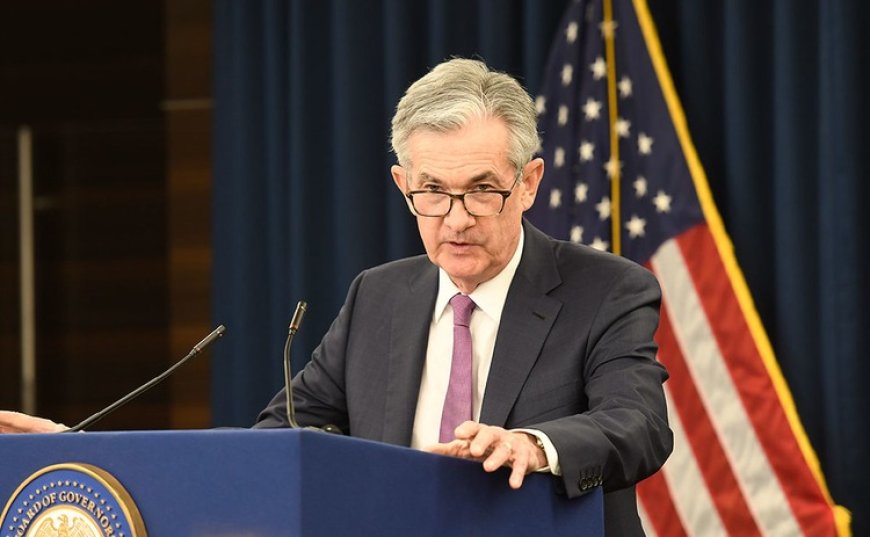Live News Coverage: Wall Street Faces Mixed Earnings Reports and Anticipates Fed Rate Decision
Stock market rally pauses as traders await Federal Reserve's rate decision. Big Tech earnings disappoint, while housing data indicates increased new home sales. Stay updated on the latest market developments.

Welcome to our live news coverage as we closely monitor the developments on Wall Street. This morning, the stock market hit a temporary pause, opening lower, as investors await a crucial rate decision from the Federal Reserve.
The spotlight is on the Fed's expected quarter-point hike in its benchmark lending rate. However, the real intrigue lies in the possibility of a second rate hike later this year, which has traders on edge.
Adding to the market's uncertainty are the recent earnings reports from Big Tech companies. Disappointing forecasts have cast a shadow on investor sentiment, exerting downward pressure on the market.
Amidst these market dynamics, all eyes are also on the housing data set to be released later today. Analysts predict an increase in new home sales as buyers turn to new constructions to tackle the ongoing issue of low housing inventory.
Stay tuned for live updates and expert analysis throughout the day, as we bring you the latest insights into these market-moving events.
Key Moments
- Market rally pauses as Fed rate decision looms
- Traders eye potential second rate hike later in the year
- Big Tech earnings disappoint, weigh on the market
- Latest housing data anticipated to show increased new home sales
- Stay tuned for market updates throughout the day
-
Past Pauses by the Fed: A Look Back at the Consequences
The Federal Reserve stands at a critical juncture as it decides on interest rates, having chosen to keep rates unchanged during its June 2022 meeting, the first time since March of that year. At this pivotal moment, the Fed faces two distinct paths. One option involves persistently raising interest rates in an effort to tackle the ongoing inflation concerns.
However, pursuing this road might risk pushing the economy into a recession if the rates are elevated to such an extent that businesses and consumers drastically cut back on spending, potentially leading to widespread layoffs. The alternative route entails adopting a more cautious approach to gauge the health of the economy.
By taking additional time to assess the situation, the Fed hopes to sustain the progress made in reining in inflation and bringing it closer to the target of 2%. Yet, there's a potential downside to this strategy as well, as consumers might not have a compelling reason to curtail their spending habits, which could perpetuate higher prices in the market.
The sentiment among traders is that the Federal Reserve is likely to favor the first option during its current meeting, as suggested by the CME FedWatch Tool. However, there is less consensus on which path the Fed will ultimately take in future meetings. It's worth noting that the Federal Reserve faced a similar predicament back in 2006, further highlighting the significance and complexity of its current decision-making process.
-
The Federal Reserve adopts a cautious stance to manage expectations

Prominent economists predict that the labor market will continue to exert inflationary pressure, prompting the Federal Reserve to implement measures to slow down the economy.
Federal Reserve Chair Jerome Powell closely monitors the labor market for signs of a more balanced demand and supply. A potential improvement could mean fewer job openings, which might alleviate wage growth and subsequently impact consumer prices.
Service-providing businesses, like restaurants and hospitals, face the challenge of higher labor costs due to their labor-intensive nature. As they offer higher compensation to attract staff, these costs may be transferred to consumers. However, some businesses find it difficult to pass on these expenses, as indicated in the Fed's Beige Book, a compilation of business survey responses.
The upcoming release of the Labor Department's Employment Cost Index for the second quarter will shed light on whether inflationary pressures have subsided in recent months. The Federal Reserve's decision won't be without debate, and a possible dissent, even though the central bank has a tradition of collegiality.
Most of the Fed's decisions have been unanimous since the rate hikes began in March 2022, with only two exceptions during the ongoing battle against inflation.
-
Promising Signs of Consumer Confidence Amidst Cooling Inflation

A renewed sense of optimism has swept across Americans as they express confidence in the economy and anticipate a reduction in inflationary pressures, reminiscent of sentiments witnessed back in 2021.
Economists are taking note of improved business conditions, and investors are growing increasingly positive about the Federal Reserve's potential success in orchestrating a soft landing. This scenario entails the central bank skillfully managing inflation without triggering a severe economic downturn.
This newfound sense of assurance comes as inflation shows signs of slowing down, even in the face of ten consecutive rate hikes initiated by the Fed since March 2022. The economy's impressive resilience has quelled fears of an imminent recession, with some Wall Street experts now suggesting that any potential mild recession might be delayed.
The key driver behind this optimistic outlook is the cooling of inflationary pressures. In June, the Consumer Price Index rose by a modest 3%, marking a notable slowdown compared to the alarming 9.1% surge recorded in June 2022. Additionally, the Fed's preferred inflation gauge, the Personal Consumption Expenditures price index, witnessed a 3.8% rise in May compared to the previous year, down from the 4.3% increase seen in April. All eyes are now on the Commerce Department, which is set to release the June reading of this critical inflation measure on Friday.
Consumer confidence is proving to be a positive sign for the Federal Reserve, as it reflects Americans' belief that inflation will eventually subside to a more manageable and familiar level.
-
Challenges Persist for Prospective Home Buyers

The summer of 2023 brings numerous obstacles for those aspiring to become homeowners. The housing market remains stagnant due to a combination of factors, including soaring prices, limited inventory, tightened credit, and higher interest rates. These conditions are deterring potential buyers and dampening the usual peak season for home sales.
One significant contributing factor is the persistent scarcity of available homes for sale. This scarcity, coupled with increased demand, is causing prices to rise further, making it difficult for many buyers to afford a home. Moreover, existing homeowners, who secured favorable mortgage rates of 2%, 3%, or 4% during the pandemic, are hesitant to list their properties and become buyers in a market where mortgage rates have climbed to 6% or higher.
Statistics from Black Knight, a mortgage data company, reveal that over 60% of current mortgage holders are holding onto loans with rates below 4%, leading them to hold off on selling in the current market environment.
As mortgage rates approach 7%, affordability worsens, making homeownership even more challenging for many Americans. The record-high monthly principal and interest payment needed to purchase the median-priced home reached $2,258 in June, straining household budgets and exceeding the recommended 30% allowance for housing expenses, taking up about 36% of the median household income.
Compounding the situation, credit availability has tightened, remaining at historically low levels since early 2013, as the industry faces capacity constraints.
Despite the current hurdles, there is a glimmer of hope on the horizon. Economists and housing analysts anticipate a drop in mortgage rates during the second half of the year, thanks to cooling inflation. Forecasts indicate that rates may end the year around 6%, providing some relief for homebuyers. However, challenges persist, and the path to homeownership remains uncertain for many in the current real estate landscape.
-
Anticipating Wednesday's Federal Reserve Decision
 On Wednesday, the Federal Reserve is poised to announce its decision to raise its benchmark lending rate to the highest level in 22 years, following a recent pause in rate hikes aimed at curbing surging inflation. Surprisingly, despite inflation easing in recent months, there's a possibility that the Fed could signal another rate increase later this year, marking its 12th hike since the series of rate hikes began in the spring.
On Wednesday, the Federal Reserve is poised to announce its decision to raise its benchmark lending rate to the highest level in 22 years, following a recent pause in rate hikes aimed at curbing surging inflation. Surprisingly, despite inflation easing in recent months, there's a possibility that the Fed could signal another rate increase later this year, marking its 12th hike since the series of rate hikes began in the spring.Investors are closely observing the Fed's July monetary policy meeting for clues on the potential future rate increase. The decision will depend on economic data over the next eight weeks, as the Fed aims to maintain the option of further rate hikes if inflation proves more persistent than anticipated.
Insight into the September decision may come from Fed Chair Jerome Powell's remarks during an upcoming gathering of central bankers and economists in Wyoming next month.
Economists speculate three possibilities moving forward: a consecutive rate hike in September, one in November, or no further rate increases after July. The unpredictability of the economy makes it challenging to ascertain the exact outcome. However, a sense of optimism is evident at present, as the economy continues to defy expectations.
-
Banc of California and PacWest Bancorp Join Forces in Merger
In a joint announcement on Tuesday afternoon, PacWest Bancorp and Banc of California revealed their plans to merge and raise $400 million in equity, just ahead of their second-quarter earnings results. The merger will result in the formation of a single bank named Pacific Western Bank, bringing together the strengths and resources of both California-based banks.
The decision to merge comes as a measure to restore confidence in the sector, following the collapse of three regional banks earlier this year. By combining their forces, the newly formed entity aims to support the banking needs of small and medium-sized businesses in California, seizing opportunities arising from the recent upheavals in the banking industry.
Jared Wolff, the current President and CEO of Banc of California, will continue to lead the merged bank. PacWest Bancorp faced significant pressure after the sudden collapse of Silicon Valley Bank (SVB) in March, which sent shockwaves through the regional banking landscape in the United States. SVB, once America's 16th-largest bank, witnessed a rapid downfall triggered by a panicked run on the bank fueled by social media speculation.






































































